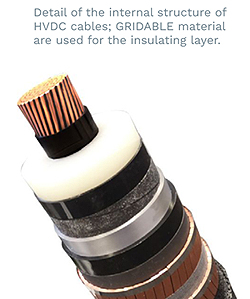 The installation of high
voltage direct current (HVDC)
technology in electrical
power grids has been
increasing due to the need to connect
electrical power over large distances.
In HVDC applications the electrical
insulation faces specific challenges
differing from those encountered
in conventional AC power grid
applications due to the stress buildup
within the insulation material caused
by the constant DC electric field
stress.
The installation of high
voltage direct current (HVDC)
technology in electrical
power grids has been
increasing due to the need to connect
electrical power over large distances.
In HVDC applications the electrical
insulation faces specific challenges
differing from those encountered
in conventional AC power grid
applications due to the stress buildup
within the insulation material caused
by the constant DC electric field
stress.
This phenomenon is referred
to as space charge accumulation,
one of the most critical phenomena
compromising the HVDC insulation
reliability and lifetime. In order to
secure reliable availability of clean
and inexpensive electricity, the EU
funded GRIDABLE project started four
years ago with the goal of improving
the HVDC insulation performance.
The project was concluded on 30th
of June 2021 and on 14th of June an
online stakeholder meeting was held.
Among the many technological and
scientific advances of GRIDABLE, the
most relevant has been the prototype
of a next generation HVDC cable with
outstanding insulation properties. In
fact, the test results on the HVDC
model cable demonstrator show the
absence of breakdown in the cable length up to 480kV and the absence
of thermal runaway. The results in
terms of leakage current measured
on the cable are also excellent. For
Nexans, one of the industrial partners
in the project, the production of such
a promising prototype was important
to demonstrate the extrusion
feasibility on existing industrial lines.
We have interviewed Gabriele Perego
and Christelle Mazel, respectively
the Nexans’ Scientific Director and
the Products Team Leader at Nexans
Research Center, who have been
working on the project since its
inception. We learned that GRIDABLE
developed a nanocomposite
formulation presenting an extremely
low leakage current and no thermal
runaway phenomenon. These are
exceptional properties and constitute
an important progress compared to
the commercial reference. Moreover,
the breakdown voltage obtained
gives the possibility to decrease the
thickness of the insulation layer and
to obtain a lightweight and more
reliable cable. Although the gain
in thickness, of the order of a few
millimeters, might seem negligible,
when scaled up to the length of
cables, it entails huge savings in
manufacturing costs, making it a
highly competitive product once on
the market and even more combined
with a lighter weight base formulation.
Christelle is very optimistic about
future developments. With the initial
objective of the project fully reached
in terms of level of performance on
the HVDC model cable demonstrator,
she expects that the new GRIDABLE
insulating material will be able to
reach extra high voltage for power
transmission at rated voltage up to
800kV. To understand why this will be
an important breakthrough, consider
that current insulation technologies
for HVDC power cables based on
extruded XLPE can reach a voltage
rate of up to 525kV and present huge
technical limits such as its maximum
conductor temperature 70°C.
Moreover, its recyclability is limited.
A remarkable feature of GRIDABLE
cables lies in their low environmental
burden thanks to the recyclability
of the PP based materials. In a
policy context characterized by the
the green transition led by the EU
(and the USA and China seem to
be following), this means a larger
economic and societal impact of
this technology. In September 2020,
Nexans disclosed its commitment to
minimize the environmental impact
of its activities and products and
to develop cabling solutions that
contribute to preservation of the
environment and saving of energy.
Therefore, limiting the environmental
impact of power cables is a major
achievement. Nexans intends to
work on further developments of
the GRIDABLE technology to meet a
key challenge: the compounding of
this material on large scale industrial
facilities and with a full control of the
cleanliness.
Co-founded by the Horizon 2020 Framework Programme of the European Union.